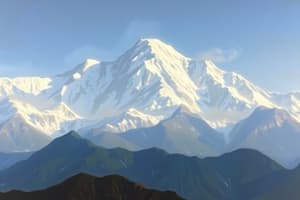Podcast
Questions and Answers
What is the total length of the Himalayan arc, as mentioned in the text?
What is the total length of the Himalayan arc, as mentioned in the text?
- 2,500 kilometers (correct)
- 3,000 kilometers
- 1,500 kilometers
- 4,000 kilometers
Which range in the Himalayas is home to Mount Everest?
Which range in the Himalayas is home to Mount Everest?
- Middle Himalayas
- Lesser Himalayas
- Greater Himalayas (correct)
- None of the above
Which country does NOT share borders with the Himalayan mountains?
Which country does NOT share borders with the Himalayan mountains?
- India
- China (Tibet)
- Bangladesh (correct)
- Nepal
Which Himalayan range is known for its hospitable climate suitable for human settlements?
Which Himalayan range is known for its hospitable climate suitable for human settlements?
How high is Mount Everest?
How high is Mount Everest?
What is the vegetation like in the cold Zone of the Himalayas?
What is the vegetation like in the cold Zone of the Himalayas?
Which zone of the Himalayas is characterized by trees and shrubs like birch, juniper, and conifers?
Which zone of the Himalayas is characterized by trees and shrubs like birch, juniper, and conifers?
What role do the Himalayas play in India's monsoon climate?
What role do the Himalayas play in India's monsoon climate?
Which of the following animals is endemic to the Himalayas?
Which of the following animals is endemic to the Himalayas?
What are some of the challenges faced by the Himalayas according to the text?
What are some of the challenges faced by the Himalayas according to the text?
Study Notes
Exploring the Majestic Himalayan Mountains in NCERT Class 9 Social Science Geography Chapter 2: Physical Features of India
In this educational exploration of NCERT Class 9 Social Science Geography Chapter 2, we'll delve into the enchanting world of the Himalayan mountains – one of India's most prominent physical features. The Himalayas form a gigantic, complex, and breathtaking landscape that spans five countries: India, Pakistan, Nepal, Bhutan, and China (Tibet).
The Himalayan Mountains: A Brief Overview
The Himalayas stretch for approximately 2,500 kilometers (1,550 miles) across the Himalayan arc. They are the world's highest mountain range and a crucial geological feature in India, shaping its climate, topography, and culture. The Himalayas are composed of three main ranges:
- The Greater Himalayas, the highest and most rugged range, home to Mount Everest (8,848 meters, or 29,031 feet) and other peaks that exceed 8,000 meters in height.
- The Middle Himalayas, which serve as a transition between the Greater Himalayas and Lesser Himalayas.
- The Lesser Himalayas, sometimes referred to as the Outer Himalayas, which boast more hospitable climate conditions than the Greater Himalayas, providing space for human settlements and agriculture.
The Himalayas: Climate and Geography
The Himalayas are divided into three distinct climate zones:
- The cold Zone (up to 3,600 meters, or 12,000 feet), where temperatures are consistently below freezing, and vegetation consists of dwarf rhododendrons and alpine grasses.
- The sub-alpine zone (3,600 to 4,800 meters, or 12,000 to 15,700 feet), where trees and shrubs such as birch, juniper, and conifers predominate.
- The alpine zone (4,800 meters and above, or 15,700 feet), where only lichens, mosses, and mountain plants thrive.
The Himalayan climate plays a critical role in maintaining India's climate balance. The monsoons bring heavy rainfall to India's plains, while the Himalayas act as a barrier that prevents the monsoon from reaching the low-lying regions of Pakistan and the Indian subcontinent's western part.
The Himalayas: Ecology and Wildlife
The Himalayan region is a natural hotspot for biodiversity. It's home to numerous endemic species, including the snow leopard, Himalayan black bear, and Tibetan wolf. The ecosystem is further rich in flora, with hundreds of plant species flourishing within its confines.
The Himalayas: Human Settlements and Cultural Significance
The Himalayas have played a pivotal role in shaping India's culture, religion, and heritage. The region is the birthplace of ancient civilizations, such as those of the Buddhist kingdoms of Tibet and the ancient Hindu cities of the Indus Valley. Today, the Himalayas are home to a diverse range of communities, each with a distinct culture, language, and customs.
Challenges and Opportunities
The Himalayas are not without their challenges. Climate change, deforestation, and pollution pose significant threats to the region's ecological balance. However, the Himalayas offer a wealth of opportunity for sustainable tourism, agriculture, and water resource management.
In conclusion, the Himalayas are an integral part of India's physical geography, offering a wealth of opportunity for students to engage with nature, culture, and ecology. Studying this magnificent mountain range fosters an appreciation for the natural world and a deeper understanding of the interconnectedness of human and natural systems.
Studying That Suits You
Use AI to generate personalized quizzes and flashcards to suit your learning preferences.
Description
Delve into the enchanting world of the Himalayan mountains in NCERT Class 9 Social Science Geography Chapter 2. Learn about the geography, climate, wildlife, human settlements, and cultural significance of the Himalayas, as well as the challenges and opportunities they present.




